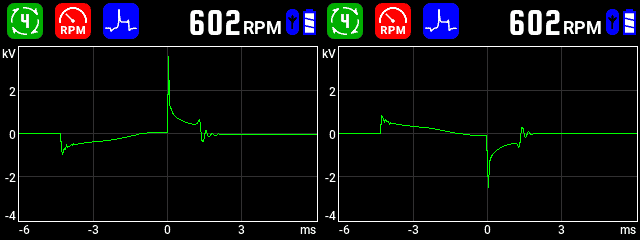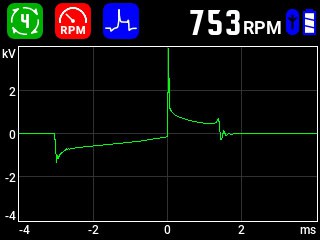This year, we’ve released a new version of our GTC505, with a number of new features to improve performance, reliability, and ease-of-use. This redesign and redevelopment was triggered by supply issues with the NXP Kinetis K60 processor we had been using. We took advantage of this opportunity, and completely reworked the tool’s electronic hardware and software. Here’s an overview of the improvements we’ve made:

Signal Conditioning & Processing Hardware
One of the biggest changes we’ve made to the Engine Ignition Analyzer is to upgrade to an STM32H7 microcontroller, which has over five times the processing capability. This new microcontroller has allowed us to take in and process much more data, which improves the resolution and accuracy of our measurements. We’ve also improved the signal conditioning electronic hardware, and added even more protections to make sure the tool works better than ever, especially on high-voltage capacitive-discharge and Kettering-type distributor systems found on older cars.

True Spark Polarity
The ‘Waveform’ view on pre-2024 GTC505s displayed ‘rectified’ spark waveforms, in an effort to make interpreting and comparing them a bit easier for the user. Unfortunately, this made it difficult to understand the relationships between positive and negative sparks on an engine, as well as forcing the user to check the polarity marking or indication on the engine, instead of being able to see it on the waveform. For these reasons, new GTC505s display ‘true’ spark polarity. Please let us know if you have a preference (either way), as it is technically possible for us to add the option to rectify the waveforms on one or both screens if people find it useful.

Parade View
Many users of our ‘old’ Engine Ignition Analyzer have asked for a way to display a ‘spark parade’, as was available on engine analyzers of the 1970s and 1980s, but the tool didn’t have enough memory or processing capability to do that. But the new one certainly does! We’ve added the capability to compare up to four spark waveforms to each other, selected the same way (and at the same time) as the crosses in the ‘Compare’ view. You can also switch between ‘Modes’, while retaining all your parade data, with and without ‘data hold’ selected (as with the ‘Compare’ view).

JPEG Screenshots
Every time you press the ‘HOLD’ button, the new GTC505 takes a ‘.jpg’ screenshot, and saves it to memory. The tool can store about 500 of these screenshots, and you can then access them by plugging the GTC505 in to a computer (via the included micro-USB cable), just like a USB ‘thumb’ drive. This is a wonderful capability for anyone looking to document ignition system performance. This is obviously useful for educators who want to show students the differences between systems, or what ‘good’ and ‘bad’ sparks look like, but is also great for comparing similar engines located in different places, or serviced at different times. You can also use this feature to collect waveform data on an engine which you maintain on a regular basis, and compare performance over time, for use in preventative maintenance.
Increased Contrast & Updated Color Scheme
We’ve upgraded the new GTC505 from a normal ‘twisted nematic (TN)’ LCD display to a wide viewing angle, higher-fidelity ‘In-Plane-Switching (IPS)’ unit. This new display offers more vibrant colors, and better viewing angles, which makes it a bit easier to take readings or see waveforms when you’re in an awkward position. We’ve also reduced the number of colors used on the Engine Ignition Analyzer’s screen, and improved the color scheme’s contrast to make it easier to see what the tool is trying to tell you. The best example of this is the ‘charging’ screen, which is now light-on-dark, like the rest of the interface; this may seem like a minor change to you, but it was actually one of the most controversial ones within GTC!

Improved Iconography & Clarified Terminology
We’ve made a variety of changes to the icons, fonts, and terms we use in both the menus and various views. Most of the changes are subtle, and users familiar with the older version might not even notice, but the whole interface has been extensively reviewed and improved. Some of the most obvious changes are removing the leading zeroes on RPM readings, and modernizing the gauge on the ‘Digital’ view’, to make the indicator ‘needle’ longer and easier to read. We’ve also added a ‘Rotary’ option to the ‘Cycle’ menu, so that you don’t have to select ‘2-Stroke’ when you’re working on an obviously four-stroke 13B-equipped Mazda RX-8. On the subject of cycles, we’ve changed all those icons from black-on-green to white-on-green, for better legibility and more consistency with the other menus.

Multi-Language Options & Status Screen
On the old GTC505, the interface language was hard-coded, meaning that if you wanted to switch languages, you had to load a different version of the firmware on the tool. This didn’t take long, but it was certainly inconvenient. Now, all you have to do to change switch to a different interface language is to press the ‘VIEW’ button for two seconds, until you get to the ‘Status’ view, then click “HOLD” to switch from one language to the next. The status screen itself is also useful in case anything goes wrong, as it can help you work with us to troubleshoot any faults which may occur (though there hasn’t had much cause to use it yet).
And There’s More to Come!
We believe the GTC505 Engine Ignition Analyzer is the best ignition diagnostic tool ever made, but we’re not sitting on our laurels. The GTC research and development team are continuing to work on the software for this tool, and it’s very easy to update, so if you buy one soon, it’ll keep getting better! We even run an e-mail newsletter, and you can sign up be notified when we have a new and improved software version.
Thanks for reading this blog-post, and please let us know if you have any ideas for future improvements to this or any other of our tools!